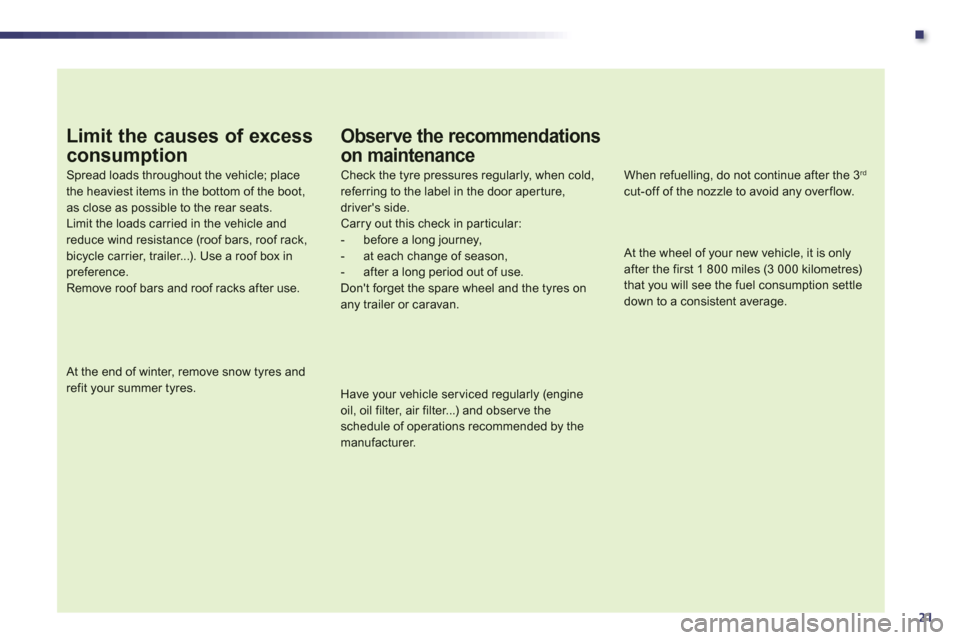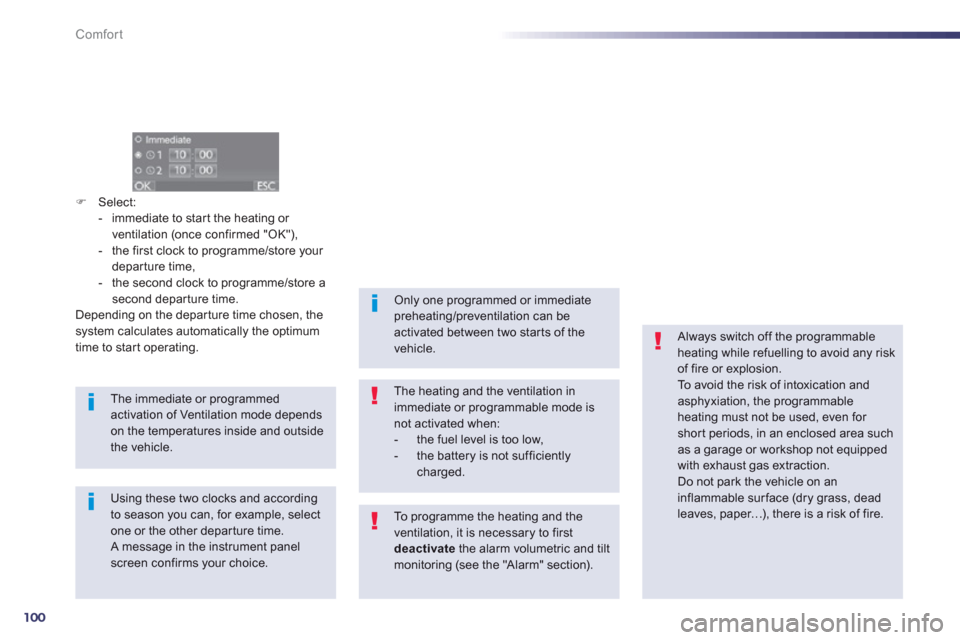Page 20 of 340

18
Familiarisation
Driving safely
Stop & Start
Going into engine STOP mode
121
The "ECO"warning lamp comes
on in the instrument panel and the
engine goes into standby; with anelectronic gear control gearbox and speeds
below 4 mph (6 km/h), press the brake pedal or put the gear lever in position N.
Going into engine START mode
Deactivation
/ Reactivation
You can deactivate the system at any time bypressing the "ECO OFF"
button; the button's
warning lamp comes on.
122
122
The system is automatically reactivated every time the engine is star ted withthe key.
Before refuelling or doing anything under the bonnet, you must switch off the ignition with the key. Th
e "ECO"
warning lamp goes off
and the engine restar ts with anelectronic gear control gearbox:
- with the gear lever in position A
or Mrelease the brake pedal,
- or with the gear lever in position N
andbrake pedal released, move the gear lever
to position Aor M ,
- or engage reverse.
In certain circumstances, the ST
OP modemay not be available; the "ECO"
warning lamp
flashes for a few seconds, then goes off. In certain circumstances,
STA R T m o d e m ay be
invoked automatically; the "ECO"warning lampflashes for a few seconds, then goes off.
Page 23 of 340

.
21
Limit the causes of excess
consumption
Spread loads throughout the vehicle; placethe heaviest items in the bottom of the boot,as close as possible to the rear seats.Limit the loads carried in the vehicle and reduce wind resistance (roof bars, roof rack, bicycle carrier, trailer...). Use a roof box inpreference.Remove roof bars and roof racks after use.
At the end of winter, remove snow tyres and refit your summer tyres.
Observe the recommendations
on maintenance
Check the tyre pressures regularly, when cold, referring to the label in the door aper ture, driver's side.Carry out this check in par ticular:- before a long journey,- at each change of season,- after a long period out of use. Don't forget the spare wheel and the tyres onany trailer or caravan.
Have your vehicle ser viced regularly (engine oil, oil filter, air filter...) and obser ve the schedule of operations recommended by the
manufacturer.
When refuelling, do not continue after the 3 rd
cut-off of the nozzle to avoid any over flow.
At the wheel of your new vehicle, it is only after the first 1 800 miles (3 000 kilometres) that you will see the fuel consumption settledown to a consistent average.
Page 66 of 340

64
Access
Fuel tank Capacity of the tank: approximately 72 litres(or 55 litres according to version).
Additions of fuel must be of at least 5 litres to be registered by the fuel gauge.
Opening the filler cap may result in an inrush of
air. This vacuum is entirely normal and results
from the sealing of the fuel system.�) Take care to select the pump that delivers
the correct fuel type for your vehicle'sengine (reminder on a label on the inside of
the filler flap).�) Open the filler cap by turning it a 1/4 turn to
the left. �) Remove the filler cap and hang it on its
carrier (on the filler flap).
Opening
If you have put in the wrong fuel for your vehicle, you must have have the tank drained and refilled with the correct fuel before you star t theengine.
With Stop & Star t, never refuel with the system in STOP mode; you must switch off the ignition with the key. - Pr
ess the switch.
This control remains active for a few minutes after switching off the ignition. If necessary, switch the ignition on again toreactivate it.
Refuelling
�)Introduce the nozzle and push it in fully
(pushing on the the metal non-return valve A
). AA�)Fill the tank. Do not continue past the thirdcut-off of the nozzle, as this may causemalfunctions. �)Refit the filler cap turning it a 1/4 turn to the right. �)Push the filler flap to close it.
Your vehicle is
fitted with a catalytic converter,
a device which helps to reduce the level of harmful emissions in the exhaust gases.
For petrol engines, you must useunleaded fuel only. The filler neck is narrower, admitting petrolnozzles only.
Page 67 of 340

2
65
Access
Low fuel level
When the low fuel level in the
tank is reached, this warning lamp comes on in the instrument panel, accompanied by an audible warning and a message in the instrument panel screen.
When it first comes on, around 7 litres of fuel
r
emain in the tank.
You must refuel as soon as possible to avoid
runnin
g out.
Fuel supply cut-off
Your vehicle is equipped with a safety device
which cuts off the fuel supply in the event of a collision.
It is still possible to use a fuel can to fill
the tank but this must be done slowly. In order to ensure a good flow of fuel, do not place the nozzle of the fuel can in direct contact with the flap of themisfuel prevention device.
Diesel misfuel prevention
Mechanical device which prevents filling the tank of a Diesel vehicle with petrol. It avoids the risk of
engine damage that can result from filling with the wrong fuel.
Located in the filler neck, the misfuel prevention device appears when the filler cap is removed.
When a petrol
filler nozzle is introduced into the fuel filler neck of your Diesel vehicle, it comesinto contact with the flap. The system remains
closed and prevents filling. Do not persist but introduce a Diesel filler
nozzle.
Operation
Tr a v e l l i ng abroad
As Diesel fuel pump nozzles may be different
in other countries, the presence of the misfuel
prevention device may make refuellingimpossible.
Before travelling abroad, we recommend that you check with the PEUGEOT dealer network,
whether your vehicle is suitable for the fuel
pumps in the country in which you want to
travel.
Page 102 of 340

100
Comfort
�)Select:
- immediate to star t the heating or
ventilation (once confirmed "OK"),
- the first clock to programme/store your departure time,
- the second clock to programme/store a
second depar ture time.
Depending on the depar ture time chosen, the system calculates automatically the optimum
time to star t operating.
The immediate or programmedactivation of Ventilation mode depends on the temperatures inside and outsidethe vehicle.
Always switch off the programmableheating while refuelling to avoid any riskof fire or explosion.
To avoid the risk of intoxication andasphyxiation, the programmable heating must not be used, even for shor t periods, in an enclosed area such as a garage or workshop not equipped with exhaust gas extraction.
Do not park the vehicle on an inflammable surface (dry grass, dead leaves, paper…), there is a risk of fire.
Using these two clocks and according to season you can, for example, select one or the other depar ture time. A message in the instrument panel screen confirms your choice.
Only one programmed or immediatepreheating/preventilation can beactivated between two starts of thevehicle.
The heating and the ventilation inimmediate or programmable mode isnot activated when: - the fuel level is too low,- the battery is not sufficientlycharged.
To p r ogramme the heating and the ventilation, it is necessary to firstdeactivate
the alarm volumetric and tiltmonitoring (see the "Alarm" section).